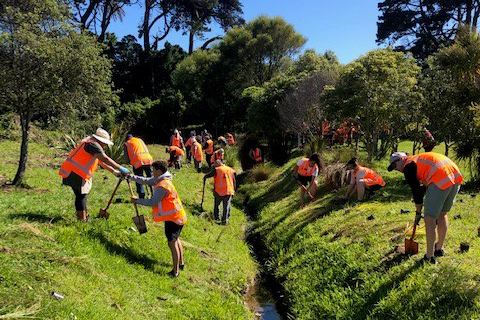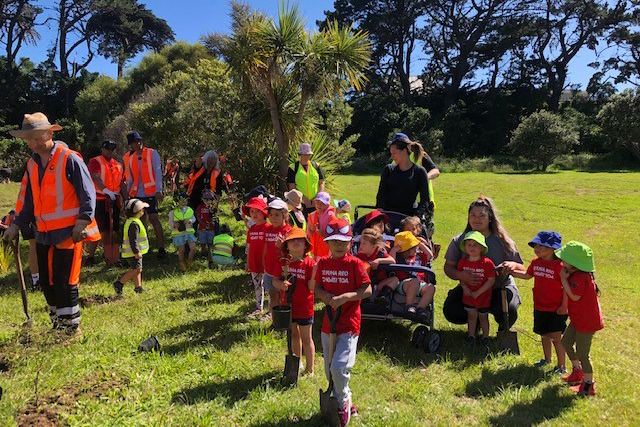Planting is not just about making the road look more attractive (although the planting does that too); planting at Transmission Gully is about soil stabilisation, protecting stream habitats, mitigating erosion, enriching biodiversity and regeneration.
Did you know that we are planting nearly 2.5 million native trees and plants, creating one of the most significant lowland native bush areas in the region?
The size of the project, and the terrain, makes it challenging work for the planting team. Check out what it takes in the video below.
Over the 2020/21 summer, the Transmission Gully Project gifted 1000 plants to our Iwi partners Ngāti Toa. The plants were a mixture of shrubs and native grasses. Ngāti Toa used the plants to supplement the riparian planting they were undertaking beside the Hukarito awa, a stream that flows into the Porirua harbour.
Riparian planting is planting beside waterways that helps prevent land erosion and protect the stream’s habitat for wildlife. The plants also act like a sieve, helping to filter out sediment and nutrients.

Volunteers get stuck in planting shrubs beside the Hukarito awa, Porirua.

Tamariki from Te Puna Reo o Ngāti Toa enjoyed a planting lesson from the Transmission Gully landscape team.

Native specimens onsite at Battle Hill Farm Forest Park, ready for planting.
With just over a million native trees and shrubs left to plant along the 27-kilometre route, the project team is gearing up for another busy winter planting season. With the help of an innovative new planting excavator a whopping 450,000 natives will go in the ground this season.
Wellington Gateway Partnership CEO, Sergio Mejia says that around 534 hectares of land surrounding the new motorway has been fenced and is being planted with around two million native trees and shrubs, including seedlings of long-living tree giants like tōtara, matai and rimu.
“We’re aiming to create one of the most significant lowland bush areas in the Wellington region. Streams along the 27-kilometre route are also being enriched with riparian planting to create better environments for native fish and birds”, says Sergio.
“All seeds have been ‘eco-sourced’ from Wellington, the Kāpiti Coast and the Akatarawa Ranges, as well as from the Transmission Gully motorway route; in other words they’re all local species.”
With many planting areas in ‘hard to reach places’ the team needed to find alternative solutions, to manually hauling hundreds of thousands of plants across hundreds of hectares. Enter Kāpiti Heliworx. Working alongside the project team, choppers are being used to transport between 1,000 and 1,800 natives at a time to their final planting destination. This not only saves the team time, but also helps prevent unnecessary backache and potential damage from carting seedlings overland.
We’re also excited about another piece of kiwi ingenuity being piloted this planting season. The brainchild of the project’s planting contractor Evergreen, a new planting excavator has been developed, to not only ‘dig the hole’, but to fertilize, and then plant selected natives in their correct location. At its top speed, it will see around 2,000 specimens planted in the ground each day.
Check out this cool photo of Evergreen’s new planting excavator being trialed:

With the increased habitat, it’s hoped that iconic songbirds like tui and bellbirds will successfully nest in the new bush and rarer species like native falcon or kārearea will migrate from the Tararua, Rimutaka and Akatarawa Ranges and kākā to and from the likes of Kāpiti Island.
The Landscape Inspection Testing Authority (LITA) has a key role to ensure all native plant species for the project are eco-sourced, and that stringent controls are in place to make sure they thrive – starting from early nursery propagation, through to final planting, and ongoing maintenance once the new motorway is open.
Each eco-sourced native seed is inspected and assigned its own unique barcode, based on where it’s sourced. LITA undertakes regular nursery inspections to check the plant’s progress during its time at the nursery. Once the natives are ready to plant onsite, LITA visits to review and approve the proposed location, and project team’s planting plan. LITA returns once the plants are in the ground, to test the quality of the planting. At the completion of the planting phase, LITA will undertake quarterly inspections, over three years, to ensure the plants continue to thrive.